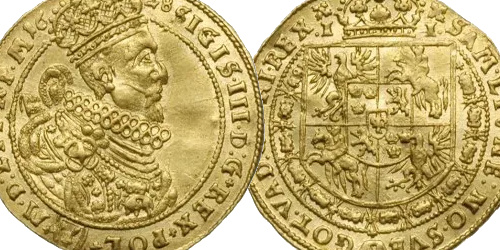Pair of one-sided printed specimen brands issued by the General Government of Warsaw.
Set from our IX Auction of 2022.
One-sided obverse printing, diagonal red Muster imprint and horizontal DRUCKPROBE perforation, and one-sided reverse printing, diagonal red Muster imprint, numbering A 000000 - A 000000 and horizontal DRUCKPROBE perforation.
Designs of Polish marks issued under the administration of the General Government of Warsaw constitute the rarest and most difficult to complete issue among all Polish designs of the 20th century. Over the course of the last two decades, a set of pattern issues with the corrected "General-Government" clause appeared at a single auction sale only once! (SNMW Auction I 2018). In 2007, the 37th WCN Auction offered seven of the eight constituting a set of pattern pairs. In the available archives, we find single listings of pairs of single-sided printed designs, as well as single pages alone, but in a set, this is only the second listing over the past two decades. Only reaching deeper into the available archives will we discover another listing of the set only at the famous 5th WCN Auction of 1993, which is still considered one of the most famous auctions during which the Dabrowski collection, still considered one of the best, was auctioned.
Based on our twenty years of experience with Polish paper money, we can confidently state that all of the one-sided specimens with the corrected clause that have been preserved so far were affixed with each corner to special, probably chemically neutral, cards with glue, and then transferred to bank branches in the form shown. In the last attached photo, approached from our private archive, we show the form in which these patterns were released by the issuer into interbank circulation.
The set, which is one of the ornaments of our Ninth Auction, comes from one of the greatest discoveries of Polish banknotes from the primary market in recent years. These specimens, along with the rest of the collection, were attached to an old-style album glue. Luckily, their first owner only trimmed the original cards used by the issuer to the size of the banknotes, and then attached them to the pages of his own album with glue that was difficult to remove. Our company undertook the dry removal, without the slightest interference with the banknotes, of only the album cards themselves, which was necessary in order to offer them for resale. Most importantly from the prospective buyer's point of view, none of the designs had been trimmed by their original owner, and also in the course of the work of removing them from the album, the surface of the banknotes was not disturbed in the slightest.
Our company considered that the original form presented would make up the value of the set. We leave it to the future buyer to decide whether it would be right to turn to a professional restoration studio to peel the banknotes themselves from the original cards the issuer used. So far, the vast majority of the designs in question have been offered after the peeling procedure, often the work was done carelessly disturbing the surface of the paper, leading to losses, as well as irreversible changes in the texture of the paper. Nonetheless, we declare that we will recommend to the future buyer a workshop, proven by us, which will professionally perform the peeling procedure with minimal impact on the texture of the banknotes themselves.
Obverse with no signs of sagging or creasing over the entire surface of the banknote. Typical for glued designs, located only in the margins, spotty thickening of the paper from excess glue under the surface. The original striped paper texture is perfectly preserved with a perfectly preserved hole at the top of each stripe, a guarantee that the bill has never been subject to wet treatment. The colors of the print are exquisitely preserved, intensely saturated, which doesn't surprise us, as they have not been exposed to sunlight since the date of issue. The Muster print also retains an emissive shine. The presentation of the printed side is excellent.
The reverse, like the obverse, is beautifully preserved, although within the upper left corner we observe a slight deformation of the paper, imitating deflection in its course. The line of deformation coincides with the border where the glue holds the paper. Nevertheless, we do not consider this to be a classic deflection, but only a deformation that has affected the structure of the paper over the years. On the lower left corner we notice a superficial crease. The original texture, as with the obverse, is exquisitely preserved with excellent striation throughout the bill. The print is intensely saturated and naturally shiny. The Muster print also retains its original shine. The presentation of the printed side is albumen.
We have no hesitation in stating that this is the best-preserved pair of one-sided designs for the 1,000-mark denomination with the revised "General-Government" legal clause .
The highest denomination from the rarest issue of Polish designs of the 20th century!
In August 1915, the General-Governorate of Warsaw was established on part of the territory of the Russian Empire occupied by the German army. On November 5, 1916, the Governor-Generals of both occupation zones issued the November 5 Act. Under a decree of December 9, 1916, the German occupation authorities established an issuing institution, the Polish National Loan Fund, which opened on April 26, 1917.
The PKKP was the issuer of the Polish mark divided into one hundred fenigs, whose rate was equalized with the German mark. Iron phenig coins and paper Polish marks were introduced into circulation. The Polish Republic, reborn in 1918, initially did not even have a substitute for its own treasury, so the Polish mark was recognized as a currency.
The reborn Polish state took over and polonized the PKKP. The stock of Polish marks printed in Berlin, inherited from the General Government of Warsaw, was allowed into circulation in its entirety.
Polish marks were put into circulation on April 26, 1917, with a guarantee of repayment up to one billion German marks. The Germans prepared two issues of paper money. The first, commonly called "jeneral" by collectors, consisted of six denominations that had syntax errors. Therefore, a second issue was prepared with corrected inscriptions and three denominations were added: 5, 10 and 1,000 Polish marks. These banknotes, called "general" by collectors, were put into circulation between July and November 1917, except for the highest denomination which hit the market in January 1918.













